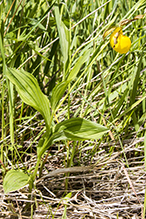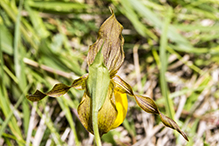large yellow lady’s slipper
(Cypripedium parviflorum var. pubescens)
Conservation • Wetland • Description • Habitat • Ecology • Use • Distribution • Taxonomy
Description |
Large yellow lady’s slipper is a 7″ to 26″ tall, erect, perennial forb that rises on one to several stems from a rhizome and fleshy, widely-spaced roots. The stems are erect, round, stout, green, and densely hairy. The hairs on the stems and leaves cause dermatitis in some people. There are 3 to 6 leaves on the flowering stem. The leaves may be crowded near the top of the stem or evenly spaced along the stem. They are alternate, erect to spreading, stalkless, and hairy. The leaf blades are broadly egg-shaped to elliptic lance-shaped, 3″ to 8″ long, and 1½″ to 4″ wide, twice as long as wide. They wrap around (sheath) the stem at the base and taper to a point at the tip. There are several prominent parallel veins arcing from the base to the tip. The veins are deeply impressed on the upper surface. The upper surface of the mature leaf blade is yellowish-green to dark green and hairless. The lower surface is similarly colored and is hairy along the main vines. The margins are untoothed and have a fringe of hairs. The inflorescence is usually 1, sometimes 2, flowers at the end of the stem. The flowers appear between May 10 and July 10, with peak blooming time June 5 to June 20 in the north and May 20 to June 1 in the south. The flowers are held upright at the end of a hairy flower stalk. There is a single, 1½″ to 4¾″ long, modified leaf (bract) on the flower stalk just below the flower. The upper surface of the bract is densely covered with silvery hairs when young, becoming almost hairless with age. The flower has 3 sepals and 3 petals. The upper sepal is egg lance-shaped, erect, wavy, somewhat twisted, and 1⅜″ to 2¾″ long. It is yellowish green with reddish-brown streaks. The two lateral sepals are united for most of their length, divided at the tip, appearing to be a single sepal (synsepal). The synsepal droops downward below the lip and is similar in size and appearance to the upper sepal. The lateral petals are linear lance-shaped and 1¾″ to 3¾″ long. They are spreading to strongly drooping, usually spirally twisted or wavy, and similar in color to the sepals. The lower petal (lip) is inflated to form a large, showy, slipper-like pouch. The lip is ⅞″ to 2⅜″ long and yellow, with red spots near the opening and on the inside surface. The margins of the opening on the upper portion of the lip are rolled inward. As with almost all Orchidaceae, the filaments and style are united to form a column. There are 2 stamens, one on either side of the column, and an enlarged, triangular, yellow staminode at the tip of the column. The fruit is an erect, ellipse-shaped, ribbed, 1¼″to 1½″ long capsule. |
Height |
7″ to 26″ |
Flower Color |
Yellow |
Similar Species |
Northern small yellow lady’s slipper (Cypripedium parviflorum var. makasin) is usually a shorter plant with smaller leaves, sepals, petals, and lip. However, there is a continuous gradation in size and the sizes overlap. The sepals and lateral petals are darker, appearing mostly reddish-brown with yellowish-green streaks. |
Habitat |
Moderate moisture. Upland hardwood forests and roadside ditches. Moderate to deep shade. In the northwest, wet prairies and sedge meadows in full or partial sunlight. |
Ecology |
Flowering |
May 10 to July 10 |
Pests and Diseases |
|
Use |
|
Distribution |
||
|
Sources Smith, Welby R. 2012. Native Orchids of Minnesota The University of Minnesota Press, Minneapolis, MN. Biodiversity occurrence data published by: Minnesota Biodiversity Atlas (accessed through the Minnesota Biodiversity Atlas Portal, bellatlas.umn.edu, 6/10/2024). |
|
| 6/10/2024 | ||
Nativity |
||
Native |
||
Occurrence |
||
|
||
Taxonomy |
|
Kingdom |
|
Subkingdom |
Pteridobiotina |
Phylum |
Tracheophyta (Vascular Plants) |
Class |
Liliopsida (Monocots) |
Order |
Asparagales (Agaves, Orchids, Irises, and Allies) |
Family |
Orchidaceae (orchids) |
Subfamily |
Cypripedioideae (slipper orchids) |
Genus |
Cypripedium (hardy slipper orchids) |
Subgenus |
Cypripedium |
Section |
Cypripedium |
Subsection |
Cypripedium |
Species |
|
Subordinate Taxa |
|
|
|
Synonyms |
|
Cypripedium calceolus var. planipetalum Cypripedium calceolus var. pubescens Cypripedium flavescens Cypripedium furcatum Cypripedium parviflorum var. planipetalum Cypripedium planipetalum Cypripedium pubescens Cypripedium pubescens var. pubescens Cypripedium veganum |
|
Common Names |
|
greater yellow lady’s slipper greater yellow lady’s-slipper hairy ladyslipper large yellow lady’s-slipper yellow ladyslipper |
|
Glossary
Bract
Modified leaf at the base of a flower stalk, flower cluster, or inflorescence.
Column
The united filaments and style of an orchid. The structure formed by the united filaments of plants in the Mallow family.
Filament
On plants: The thread-like stalk of a stamen which supports the anther. On Lepidoptera: One of a pair of long, thin, fleshy extensions extending from the thorax, and sometimes also from the abdomen, of a caterpillar.
Rhizome
A horizontal, usually underground stem. It serves as a reproductive structure, producing roots below and shoots above at the nodes.
Sepal
An outer floral leaf, usually green but sometimes colored, at the base of a flower.
Synsepal
A floral structure formed by the partial or complete fusion of two or more sepals.
Visitor Photos |
||
Share your photo of this plant. |
||
This button not working for you? |
||
Dan W. Andree |
 |
Greater Yellow Lady's Slipper... |
Chris Coopman |
 |
MinnesotaSeasons.com Photos |
||
 |
 |
|
Plant |
Plant | |
 |
 |
|
Plant |
Plant | |
 |
 |
|
Flower |
Flower | |

|
 |
|
| Flower | Flower |
|
 |
 |
|
Flower |
Sepals and lateral petals | |
 |
 |
|
Leaves |
Leaves | |
 |
||
Leaf |

Visitor Videos |
||
Share your video of this plant. |
||
This button not working for you? |
||
|
Other Videos |
||
OrchidWeb - Cypripedium parviflorum var. pubescens |
About
Published on May 8, 2013 Order this plant today (if in stock): Video narrated by Jerry Fischer. |
Greater Lady's Slipper (Cypripedium parviflorum) Close-up |
About
Uploaded on Jun 17, 2010 Photographed at the Rydell NWR, Minnesota (16 June 2010). |

|
Created: 10/7/2005 Last Updated: © MinnesotaSeasons.com. All rights reserved. |






